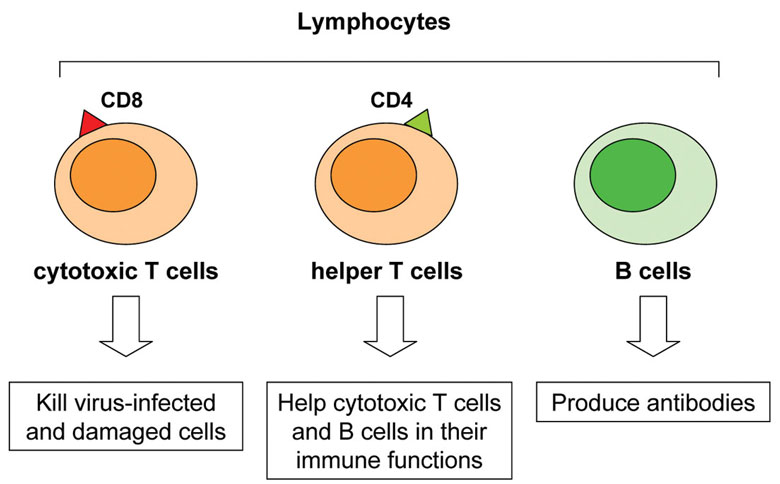In my previous two posts, I discussed acute lymphoblastic and myeloid leukemia, however, there are two other types of leukemia that are labelled as chronic. Usually in medical terms, the word chronic means to be continuing for a long time, or recurring, therefore a disease labelled chronic would be continuing for a long duration. On the other hand, an acute disease would have a rapid onset or last for a short course. Therefore, chronic lymphocytic and myelogenous leukemia tends to progress slowly over the course of many years. I'll be discussing the two diseases in more detail below.
Chronic Lymphocytic Leukemia
In the UK, around 8,600 cases of leukaemia are diagnosed and about 3,200 (37 percent) of these are chronic lymphocytic leukaemia. It is more common in older people, most cases occurring in people over 60 and is rare in people under 40. Men are more likely to develop chronic lymphocytic leukaemia than women, however it is not known why. Although in its early stages, there are usually no noticeable symptoms, as the condition develops, symptoms can include repeated infections occurring over a short space of time, tiredness due to a lack of red blood cells, unusual bleeding and bruising, fever, night sweats, bone pain, weight loss, swollen spleen and swollen lymph nodes.
Classified according to the type of white blood cells affected, lymphocytic leukaemia affects the type of white blood cells called lymphocytes. In the bone marrow where stem cells are produced that can mature into red blood cells, white blood cells and platelets, stem cells start overproducing white blood cells that are not fully developed which are lymphocytes. The overproduction of lymphcytes is at the expense of other blood cells, resulting in a lack of red blood cells and platelets that cause tiredness and increasing the likelihood of excessive bleeding. In some people with chronic lymphocytic leukaemia, the body's immune system can start attacking red blood cells and cause haemolytic anemia. As white blood cells are not properly formed, immature lymphcytes are much less effective at fighting bacteria and viruses.
It is not known what causes leukaemia, however, there are several risk factors that may increase your chances of developing chronic leukaemia which include having a family history of the condition, being of European, American or Australian origin, having certain medical conditions such as pneumonia, sinusitis or shingles, and being male.
Some people can live or years or decades with chronic lymphocytic leukaemia without developing systems or needing treatment and so it may not necessarily always be required. In such cases, a policy of watchful waiting will be employed, involving regular visits to the doctor and blood tests to closely monitor the patient's condition. If treatment is required, chemotherapy will usually be recommended and radiotherapy may be needed to shrink swollen lymph nodes. Treatment cannot cure chronic lymphocytic leukaemia completely but can slow its progression and lead to remission.
Chronic Myelogenous Leukemia
A rare type of cancer, chronic myelogenous leukemia affected around 680 people in the UK in 2001 out of the 8,600 people diagnosed with leukaemia. It can affect people of any age, but is more common in people aged 40-60. Classified according to the type of white blood cell affected by the cancer, chronic myelogenous leukemia affects the myeloid cells. A genetic mutation causes the stem cells in bone marrow to over-produce white blood cells that correspond to the drop in levels of red blood cells and platelets which causes symptoms of anemia such as tiredness and excessive bleeding. As the condition develops, symptoms include tiredness, weight loss, night sweats, feeling of bloating, bruising, and bone pain. The outlook depends on how well a person responds to medication; most patients, numbering 60 to 65 percent, do well on imatinib tablets which taken daily for life. For those who do not, more than half respond to one of the alternative drugs: nilotinib, for example. For those who fail these drugs or cannot tolerate them, they may be offered a bone marrow transplant if it is suitable treatment. If diagnosed early, the outlook is excellent, with almost 90 percent of people living at least five years after diagnosis.
Cells affected:
Lymphocytes

It is any of the three types of white blood cells responsible for immune responses. There are two main types of lymphocytes: B-cells and T-cells, as well as natural killer cells. B-cells make antibodies that attack bacteria and toxins while the T-cells attack body cells themselves when they are taken over by viruses or have become cancerous. Lymphocytes secrete products (lymphokines) that modulate functional activities of many other types of cells and are often present at sites of chronic inflammation. Natural killer cells play a major role in defending the host from tumors and virally infected cells, distinguishing infected cells and tumors and when activated in response, release cytotoxic granules that destroy the altered cells.
Myeloid cells

The name refers to the granulocyte precursor cell in the bone marrow or spinal cord stem cells. They are controlled by distinct transcription factors that follow on by a terminal differentiation in response to specific stimulating factors and release into the circulation. When pathogens invade cells, myeloid cells go into local tissues via chemokine receptors, where they are then activated for phagocytosis and secretion of inflammatory cytokines, therefore, plays a major role in immunity. Phagocytosis is the process in which a cell engulfs a solid particle to form an internal vesicle known as a phagosome.




